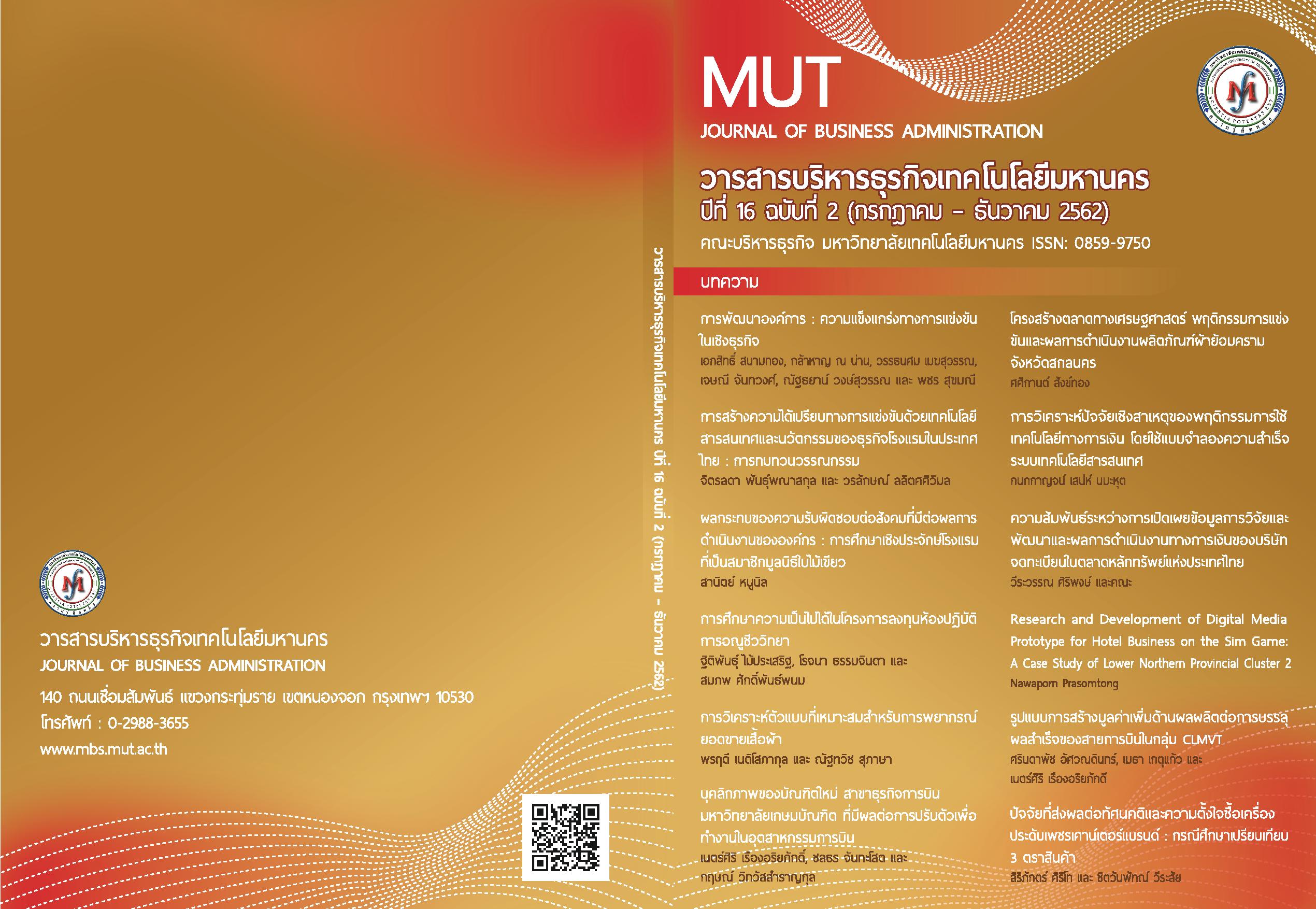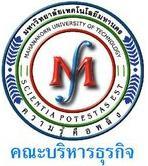Feasibility of Establishing Single ASEAN Airline along the Mekong River Border (CLMVT) from the perspectives of Aviation Personnel, Thailand, aimed to study
Keywords:
Keywords: Feasibility, Single ASEAN AirlineAbstract
The research titled “Feasibility of Establishing Single ASEAN Airline along the Mekong River Border (CLMVT) from the perspectives of Aviation Personnel, Thailand, aimed to study 1) information of intellectual capital, organizational capital and achieving success of airline business in the CLMVT group 2) a causal model of factors affecting creating value added from products with existing resources excellently by using VAIC –Value Added Intelligent Coefficient and 3) feasibility of establishing Single ASEAN airline along the Mekong River Border (CLMVT). The researcher collected data from 415 aviation personnel samples at Great Mekong Sub-region Airport.
The research found that the causal model of factors affecting creative value added from products with existing resources excellently by using VAIC –Value Added Intelligent developed fit the empirical evidences and it can forecast at a good level and acceptable at 49 percent which passed the criterion of 40%. Causal relationship at a significance level of 0.05 found that both intellectual capital and organizational capital have a causal relationship between creating value added from products with existing resources excellently by using VAIC –Value Added Intelligent of Single ASEAN Airline along the Mekong River Border (CLMVT). In addition, intellectual capital has a causal relationship between organizational capitals of single ASEAN airlines along the Mekong River (CLMVT). The feasibility study of establishing single ASEAN airline along the Mekong River Border (CLMVT) showed that it is congruent with the strategic determination plan for developing strategy of building regional cross border trade connectivity which is one of the gateway concept “by man” by building relationship with a small group through a seminar which included an invitation of public and private executives and leading businesspeople from CLMVT (Cambodia, Laos, Myanmar, Vietnam and Thailand) to exchange views and design new strategies together in order to build a close relationship and expand to a big relationship network to a national level and sub-regional level in the future and can use them for developing the strategies for promoting, supporting and creating factors supporting airline business operation in the Mekong River Sub-region along with the border of CLMVT countries in the future.
References
นงลักษณ์ วิรัชชัย. 2542. ความสัมพันธ์โครงสร้างเชิงเส้น (LISREL): สถิติวิเคราะห์สำหรับการ
วิจัยทางสังคมศาสตร์และพฤติกรรมศาสตร์. กรุงเทพฯ: โรงพิมพ์จุฬาลงกรณ์มหาวิทยาลัย
,น. 32, 84.
เพ็ญแข ศิริวรรณ. 2546. สถิติเพื่อการวิจัยโดยใช้คอมพิวเตอร์ (SPSS Version 10.0). (พิมพ์ครั้งที่
2). ภาควิชาคณิตศาสตร์และสถิติ คณะวิทยาศาสตร์และเทคโนโลยี
มหาวิทยาลัยธรรมศาสตร์.
สุชาติ ประสิทธิ์รัฐสินธุ์. 2551. เทคนิคการวิเคราะห์ตัวแปรหลายตัวสำหรับการวิจัยทาง สังคมศาสตร์ และพฤติกรรมศาสตร์ (คู่มือนักวิจัยและนักศึกษาระดับปริญญาโทและ ปริญญาเอก) :
หลักการ วิธีการ และการประยุกต์ = Multivariate techniques for social and behavioral
sciences research (handbook for researchers and graduate students) : principles,
methods and applications. (พิมพ์ครั้งที่ 6). กรุงเทพฯ: สามลดา, น. 224-227.
สุวิมล ติรกานันท์. 2550. ระเบียบวิธีวิจัยทางสังคมศาสตร์: แนวทางปฏิบัติ. โรงพิมพ์แห่ง
จุฬาลงกรณ์ มหาวิทยาลัย, กรุงเทพฯ, น. 44-46.
เสนีย์ สุวรรณดี. 2561. ไทยโพสต์, บุคลากรการบินขาดแคลนหนัก เร่งปั้นคนด่วนหวั่นแผนฮับ
การบิน สะดุด,วันที่สืบค้นข้อมูล 1 มกราคม 2562 แหล่งที่มา https://www.thaipost.net/main/detail/5201
Arbuckle. J. J. 1995. AMOS user, s guide. Chicago: Small Waters Corporation, p. 529.
Bollen, K. A. 1989. Structure equations with latent variables. New York: John Wiley &
Sons, pp. 257-258
Brown, M. W. & Cudeek.R. 1993. Alliterative ways of assessing model fit, in testing
Structural equation model. New Jersey: Sage Publication, p. 270.
Byrne, Barbara M. 2001. Structural equation modeling with AMOS: basic concepts, applications, and programming. Hahwah, New Jersey: Lawrence Erlbaum Associates, p. 89.
Cochran, W. G. 1977. Sampling Techniques. (3rd ed.). New York: John Wiley & Sons,
pp. 1-2.
Cronbach, L. J. 2003. Essential of Psychology Testing. New York: HarperCollins Publishers, p. 204.
Hoogland, J. J., & Boomsma, A. 1998. Robustness studies in covariance structure
modeling: An overview and a meta-analysis. Sociological Methods & Research, Vol. 26, pp. 329–367.
Hu & Bentler. 1999. Cutoff criteria for fit indexes in covariance structure analysis:
Conventional criteria versus new alternatives, Structural Equation Modeling,
6(1), 1-55. Jasmina Ognjanović. (2017) “Relations of Intellectual Capital Components in Hotel
Companies” University of Kragujevac, Faculty of Hotel Management and Tourism in
Vrnjačka Banja
Joreskog. K. G. & Sorbom. D. 1993. Lisrel 8: Structural Equation Modeling with the
Simplis command language. Chicago: Software International, p. 26.
Kelloway, E. Kevin. 1998. Using LISREL for structural equation modeling. New Jersey:
Sage Publication, p. 45.
Kline, P. 1994. An easy guide to factor analysis. London & New York: Routledge, p. 84.
Kotler, P. & Keller, K. 2006. Marketing and Management. New Jersey: Pearson Prentice
Hall, pp. 50-51.
Saris. W. E. & Strenkhorst. L. H. 1984. Causal modeling non experimental research :
An Introduction to the lisrel approach. Dissertation Abstract International.
47(7), 2261-A.
Silván, Marika. 1999. A model of adaptation to a distributed learning environment.
Pro Gradu Thesis in Education, Department of Education, University of
Jyväskylä, p. 42.
Zeithaml, V. A. 1988. Consumer perceptions of price, quality, and value: A means-
end model and synthesis of evidence. Journal of Marketing, 52(3), 2-22.
Published
Issue
Section
License
ข้อความ ข้อคิดเห็น ข้อมูล เนื้อหา รูปภาพ แผนภูมิ แผนผัง เป็นต้น ที่ปรากฏและแสดงในบทความต่างๆ ในวารสารบริหารธุรกิจเทคโนโลยีมหานคร ถือเป็นความรับผิดชอบโดยตรงของผู้เขียนบทความนั้นๆ มิใช่เป็นความรับผิดชอบใดๆ ของวารสารบริหารธุรกิจเทคโนโลยีมหานคร และมหาวิทยาลัยเทคโนโลยีมหานคร
บทความที่ตีพิมพ์ในวารสารบริหารธุรกิจเทคโนโลยีมหานคร ถือเป็นลิขสิทธิ์เฉพาะของคณะบริหารธุรกิจ มหาวิทยาลัยเทคโนโลยีมหานคร หากบุคคลหรือหน่วยงานใดต้องการนำทั้งหมดหรือส่วนใดส่วนหนึ่งไปเผยแพร่ต่อหรือเพื่อกระทำการใดๆ จะต้องได้รับการอนุญาตเป็นลายลักษณ์อักษรจากคณะบริหารธุรกิจ มหาวิทยาลัยเทคโนโลยีมหานครก่อนเท่านั้น


